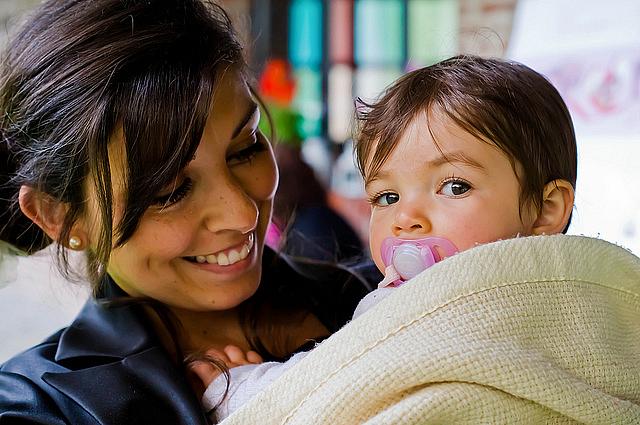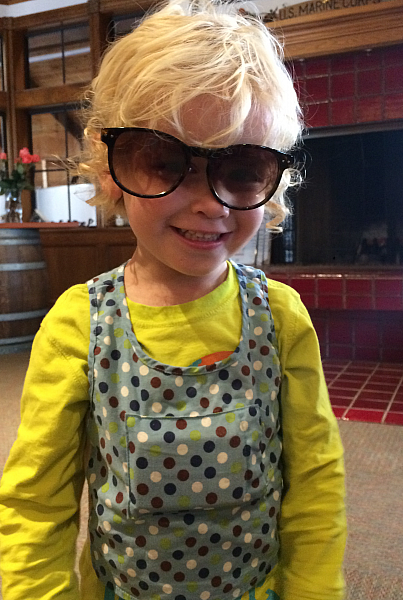New programs seek to keep children from falling into the word gap

In reporting on language spoken to kids, I had to be creative in finding sources — and look inward to discover more.
I stood in front of the door of Apartment 8 in a housing project in Houston, hoping someone would answer the repeated knocks. The October day had been hot and sticky, but now in the early evening the sky had melted into a fantastical pink and blue. Beside me, a young language coach named Gracie nervously tugged at her rolling bag. A gaggle of smiling kids checked on us periodically, making sure we had arrived at the correct door.
I was shadowing Gracie as she was to meet with a family to do a combination of early-language intervention and nutrition counseling. Inside that rolling bag was fresh snacks of fruit, along with fake food and books — fodder for our discussion. Or at least that’s what we were supposed to be doing.
After a few long minutes of waiting, a man opened the door and told us the mom we were supposed to meet was still at work. Gracie agreed to reschedule with him. I was disappointed.
After 1,500 miles on a plane and hours spent driving across a sprawling city in a rental car, I wanted to observe that family. And I worried I wouldn’t have enough time to find another session.
My work for the 2016 National Fellowship centered on programs created to address a persistent and thorny problem: language and brain development for kids born into disadvantaged families. The so-called “word gap” shows up early in life. By 18 months, kids from homes with higher socioeconomic status hear more than kids from lower-income homes. And from there the gap only grows. It leads to an achievement gap in school, work and life.
Part of the reason this gap may be so prevalent, experts think, is because it starts so early in life.
So what if that gap could be erased by getting all kinds of families to talk to their kids in a richer, more varied way?
For my project, I visited programs seeking to do just that. In East Palo Alto, I visited the Habla Conmigo program. It combines parenting classes with fun activities. The Spanish-language program consists of two parts. On Tuesdays, the parents attend an “academia,” where they chat with a coordinator about brain development, challenges they are having, and topics like parenting styles. During the meeting, childcare is provided for the kids.
On Thursdays, they go to their “practica” where they rehearse skills like setting limits or using clear, label-rich language with their tots.
Just up the road, I visited a library-based program run by a nonprofit called LENA that takes a slightly different approach. The organization has created a pager-sized “language pedometer” that captures all the language a child hears during the day and generates reports. That information, along with classes on talking, reading and singing to children, can help parents adjust how and how much they speak to their children. One graduate of LENA’s program told me that she and her mother competed to see who could score higher on the word-count report.
Of course, the number of words is an indicator of how much conversation is taking place. And the richer the conservations, the better. LENA’s recorders also capture the number of so-called conversational “turns” — the number of times a parent speaks and the child responds. Or, you know, what adults would call a conversation.
In Houston, I visited with the researchers who run the Play and Learning Strategies or PALS program, where Gracie is a coach like many others — young, female, bilingual, friendly.
All of these interventions seem to be working, although the work is fairly new, so the evidence from long-term studies will take time. I wrote in my GOOD story about how parents seem to find parenting more rewarding after taking these classes, and are less likely to be depressed.
When I was reporting this project, I had to be creative in finding sources. From the start, I wanted to get the voices of kids and parents into the story. My initial idea was to follow a few families as they wound their way through these programs, but the timing was tricky. Most of the interventions didn’t start until after the school year got into gear — meaning October. I didn’t have much time. It was also a long process to get the permission I needed to observe different programs.
After the door was closed in the housing project in Houston, I was unable to get permission to observe a different session. I ended up watching a recording of what would have happened in the session. In Palo Alto, it was challenging to speak to participants in the Habla Conmigo program — but I was able to get some graduates of the program from previous years to speak with me.
In a way, it was more helpful to speak with parents who had participated in these programs in the past. One mother told me how the program had changed how she parents her other children, too.
I also learned the importance of looking at the project through my own lens. I have two small kids at home, so I strapped a recorder on my three-year old and off we went.
A child wears a LENA word-counting device.
When I was looking back at my report, I noticed that our words and conversational turns were high during most of the day. We scored in the 80th percentile for talking and for conversational turns, with around 14,000-16,000 words spoken per day.
In the original word gap study done by Betty Hart and Todd R. Risley, the researchers found children whose families were on welfare heard about 600 words per hour. Working-class children heard 1,200 words per hour, and children from professional families heard 2,100 words per hour.
There was one notable exception. In the evening, during the last hour of recording, I noticed that adult words were high — but conversational turns were low. As I wrote in my story for Popular Science, that led me to one conclusion: We were rushing through the bedtime story.
The process of reporting these stories helped me deepen my knowledge of child development, and I will continue to spin stories off from the work I’ve done. I’m also talking differently to my own children — especially at the end of the day.
Photo by Maria Grazia Montagnari via Flickr.

